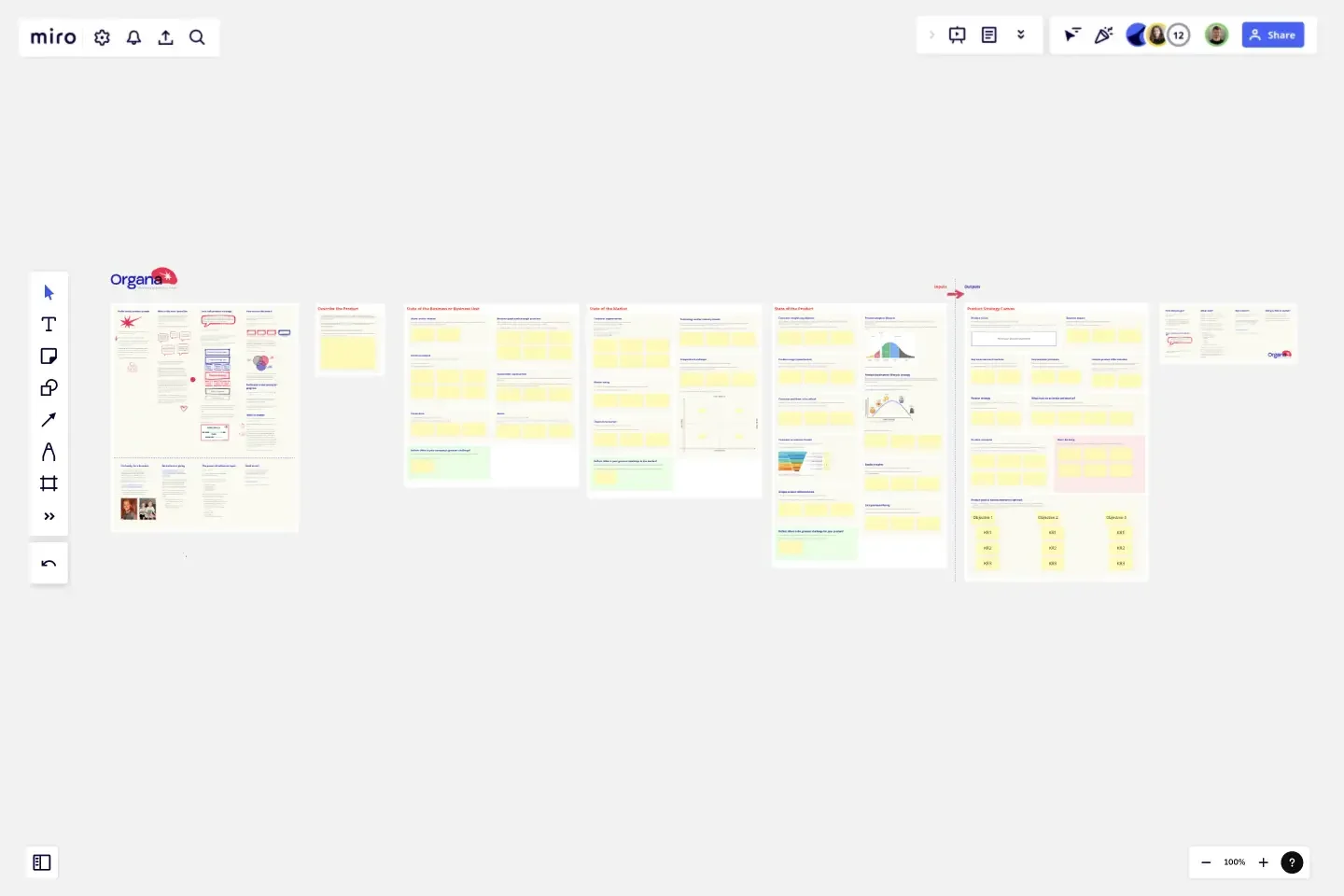Product Strategy Canvas
Creating a product strategy is a job that most product folk do quite rarely, often under pressure and with not enough time.
Because PMs don't create strategies regularly, many of them aren't natural at the process, so when we need to create one, there’s a good chance we freeze. When we recover from the foetal position, we wonder, “where on earth do I start?”
Enter the Product Strategy Canvas: a tool designed to be repeatable, flexible, and lightweight. Drawing inspiration from various successful models, we aimed to simplify the intricate process of strategy creation, catering to those who find it daunting or simply lack time.
We're mindful that one size doesn't fit all. This might be a lot to wrap your head around for junior product professionals or those just starting out in product management. Having said that, knock yourself out and give it a go. If nothing else, you’ll learn a lot. For seasoned directors of product, CPOs, or experienced strategists, you likely have your own approach, but there might be something useful here for you as well.
By streamlining the process and focusing on three critical areas (the state of the business, market and product), you can concentrate on the substance of your strategy and the collaboration it demands.
The canvas serves as a beacon, lifting you from the quagmire of your backlog to provide a clear view of the bigger picture, enabling you to chart a strategic course for your product.
The Product Strategy canvas is a MIRO template that helps product leaders craft a product strategy by following a step-by-step process of gathering data and then using that data to articulate key focus areas that help inform goals, roadmaps, and plans.
This canvas is ideal for Product Managers and Product leaders who wish to follow a repeatable process in order to gather the insights needed to make difficult prioritisation decisions in the form of a Product strategy. This is helpful when you're low on time, do this process rarely and/or wish to approach it collaboratively.
We’ve tested and iterated our canvas with clients, workshop participants, and industry mates and we now proudly share the Product Strategy Canvas in Miro for free under a Creative Commons Licence.
To make the most of this canvas, create a copy and try to fill in each frame without getting stuck. If you don't know the answer, capture the name of someone who does. Once all three input frames are filled in, you should have enough insights to decide on what your team(s) will focus on, in other words, to create a product strategy.
This template was created by Brendan Marsh (Organa).
Discover more product strategy templates to help you build your next big thing.
Get started with this template right now.
Product tone of voice
Works best for:
Product Management, Planning
The Tone of Voice Workshop template helps product teams define and align on brand tone and messaging. By facilitating collaborative workshops, exploring brand personality traits, and defining tone guidelines, this template ensures consistent and impactful communication. With sections for identifying target audience personas, articulating brand values, and crafting messaging principles, it enables teams to create authentic and compelling brand voices. This template serves as a foundation for building strong brand identities and resonating with customers across all touchpoints.
Product Vision
Works best for:
Product Management, Planning
The Product Vision template helps articulate a clear and compelling vision for product development. By defining goals, target markets, and success metrics, this template aligns teams around a shared vision. With sections for outlining product features, benefits, and competitive advantages, it communicates the value proposition effectively. This template serves as a guiding light for product teams, inspiring creativity and focus as they work towards bringing the product vision to life and achieving business objectives.
Outcome Mapping Template
Works best for:
Diagrams, Mapping, Project Management
Use Miro’s outcome mapping template to improve your operational efficiency. Outcome mapping will help you visualize all the possible strategic outcomes for your upcoming project, allowing you to see into the black box to identify any potential challenges along the way.
Work Plan Template
Works best for:
Mapping, Project Planning
A work plan is essentially a roadmap for a project. It articulates the steps you must take to achieve the desired goal, sets demonstrable objectives, and establishes measurable deliverables. An effective work plan guides you throughout the project lifecycle, allowing you to realize an outcome by collaborating with your team. Although work plans vary, they generally contain four core components: goals, strategy, tactics, and deliverables.
PI Planning Template
Works best for:
Agile Methodology, Strategic Planning, Software Development
PI planning stands for “program increment planning.” Part of a Scaled Agile Framework (SAFe), PI Planning helps teams strategize toward a shared vision. In a typical PI planning session, teams get together to review a program backlog, align cross-functionally, and decide on the next steps. Many teams carry out a PI planning event every 8 to 12 weeks, but you can customize your planning schedule to fit your needs. Use PI planning to break down features, identify risks, find dependencies, and decide which stories you’re going to develop.
Design Brief Template
Works best for:
Design, Marketing, UX Design
For a design to be successful, let alone to be great, design agencies and teams have to know the project’s goals, timelines, budget, and scope. In other words, design takes a strategic process—and that starts with a design brief. This helpful template will empower you to create a brief that builds alignment and clear communication between your business and your design agency. It’s the foundation of any creative project, and a single source of truth that teams can refer to all along the way.
